Are You Willing to Lose, Part 2
Yesterday in Part 1, we discussed the idea that while losing is a part of trading, it still must be done the right way. We also talked about how a fear of losing can characterize our trading if we allow it, much to our detriment if left unchecked. However, as Mark Ritchie’s comment emphasized, a willingness to lose is fundamental to turning a profit.

I'm not a cat fan, but this one has guts!
The ‘food for thought’ question I left you with was along the lines of “what characterizes your trading approach: fear or confidence?” Hopefully that’s a question you’re willing to honestly answer, so let’s move forward.
The best traders don’t allow their fear to dictate their success. Yes, they walk the line well. They respect the market and they keep risk in consideration, but they’re confident enough to act when their signal comes along and they move with conviction. They put in the work, identify their plays, and stick to those which are suitable for them. They know what they can lose, and then they go for it.
So, how do you get to that level?
Take Good Trades
Simple enough, right? But I should explain…
To take good trades doesn’t mean take ‘winning’ trades, because of course you can’t know (unfortunately) how they’ll turn out ahead of time. A crystal ball isn’t needed. What it means is take the trades which suit you, which are within the confines of your trading plan. If you don’t have a plan, stop reading this and go make one (anything is better than nothing). You can’t throw caution to the wind or lower your standards, but if all else is in line, then hit the good trades without hesitation over losses. If you’ve defined your risk and have a safety net in place, then be willing to deploy that capital.
Change With Care
Periodically, we all desire some sort of change. Out of impatience, we too often approach those situations the wrong way, and we should be careful.
For example, the trader who casts his fear aside and is willing to lose must still approach his trading the right way. For those aiming higher, a desire to make more needs to outweigh a worry of losing more, yes, but too many approach this adjustment from the wrong standpoint.
In his book, One Good Trade, Mike Bellafiore discusses the trader who wants to learn to make $5k by first losing $5k. Going out and losing $5k doesn’t mean you’re now prepared to make $5k, so don’t prove your willingness to lose by rushing out and widening your max loss – that’s not a solution to anything but taking bigger rips to your account.
Being willing to lose is about showing up prepared to trade confidently and responsibly, not recklessly.
Watch the Right Numbers
Trading is about two sets of numbers: the prices on your screens, and your P&L. Too many traders place their primary focus on the wrong numbers (P&L), and give their leftover, secondary attention to prices.
And they pay for it, too.
Some simply hide their P&L numbers, either for their account or for open positions in order to prevent giving their attention to the wrong numbers. Your job is to stay focused on the game, not the scoreboard!
The condition of your P&L will have some influence, yes, but make sure you’re not trading solely in response to it. Doing so will lead to costly mistakes, such as trying to go bigger when you’re struggling in an attempt to make it back. Instead, focus on the price action for clues – it will tell you what you most need to know.
Here’s the bottom line:
We all know we must accept risk in the markets in order to play and profit, but how willing are you to lose? It’s a question only you can answer, and for too many, their unwillingness to lose will ironically leave them either sidelined in fear, or fully-involved as a stuck holder in a position they should have long since closed. If you’re going to play this game, get your head right and show up ready to play – win or lose.
Trade Like a Bandit!
Jeff White
Producer of The Bandit Broadcast






